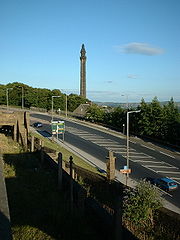
Wainhouse tower
Encyclopedia

Folly
In architecture, a folly is a building constructed primarily for decoration, but either suggesting by its appearance some other purpose, or merely so extravagant that it transcends the normal range of garden ornaments or other class of building to which it belongs...
in the parish of King Cross
King Cross
King Cross; originally the site of an ancient stone cross is a Ecclesiastical parish created in 1845 in the Metropolitan Borough of Calderdale, West Yorkshire, England. Part of the Diocese of Wakefield. It is located along the top of a ridge above the town of Halifax...
, on the south west side of Halifax
Halifax, West Yorkshire
Halifax is a minster town, within the Metropolitan Borough of Calderdale in West Yorkshire, England. It has an urban area population of 82,056 in the 2001 Census. It is well-known as a centre of England's woollen manufacture from the 15th century onward, originally dealing through the Halifax Piece...
, Calderdale
Calderdale
The Metropolitan Borough of Calderdale is a metropolitan borough of West Yorkshire, England, through which the upper part of the River Calder flows, and from which it takes its name...
West Yorkshire
West Yorkshire
West Yorkshire is a metropolitan county within the Yorkshire and the Humber region of England with a population of 2.2 million. West Yorkshire came into existence as a metropolitan county in 1974 after the passage of the Local Government Act 1972....
in England
England
England is a country that is part of the United Kingdom. It shares land borders with Scotland to the north and Wales to the west; the Irish Sea is to the north west, the Celtic Sea to the south west, with the North Sea to the east and the English Channel to the south separating it from continental...
. At 275 feet (83.8 m), it is the tallest structure in Calderdale and the tallest folly in the world, and was erected in four years between 1871-1875. The main shaft is octagonal in shape with a square base and 403 stairs leading to the first of two viewing platforms.
The tower was designed by architect Isaac Booth as a chimney
Chimney
A chimney is a structure for venting hot flue gases or smoke from a boiler, stove, furnace or fireplace to the outside atmosphere. Chimneys are typically vertical, or as near as possible to vertical, to ensure that the gases flow smoothly, drawing air into the combustion in what is known as the...
to serve the dye works owned by John Edward Wainhouse (1817-1883). The height of the chimney was to satisfy the Smoke Abatement Act of 1870 which required the building of a tall chimney, to carry smoke out of the valleys in which the factories were built. A much simpler chimney would have satisfied the requirements but Wainhouse insisted that it should be an object of beauty.
In 1874 John Wainhouse sold the mill to his works manager who refused to pay the cost of building the chimney so Wainhouse kept the tower for himself and used it as an observatory. Booth left after a dispute and was replaced by another local architect, Richard Swarbrick Dugale, who is responsible for the elaborate galleries and the corona dome at the top of the tower. The tower was completed on 9th September 1875, at a cost of £14,000.
The tower is open to the public during bank holidays.

